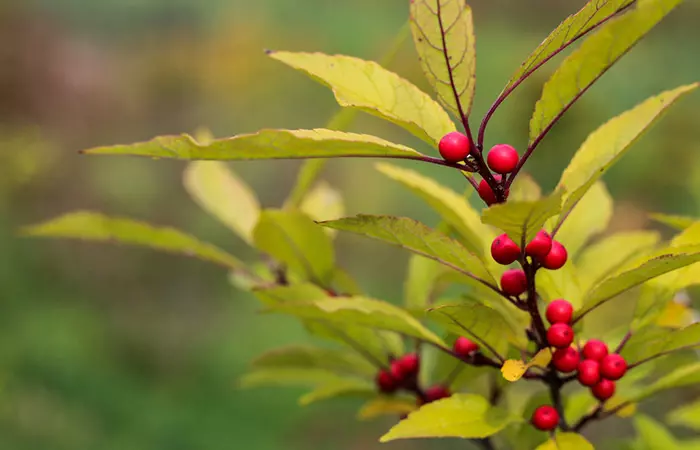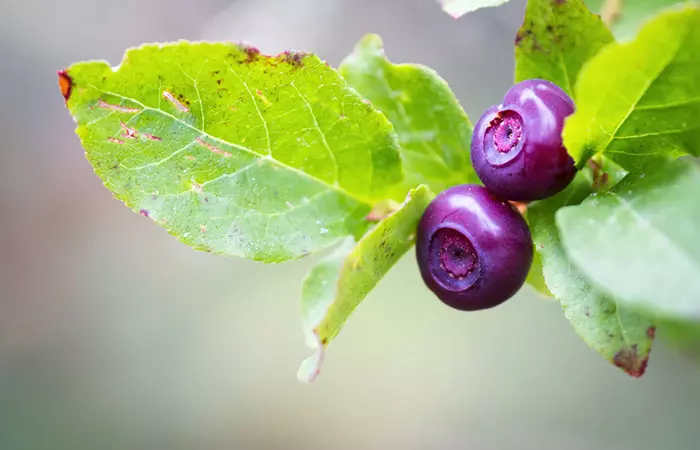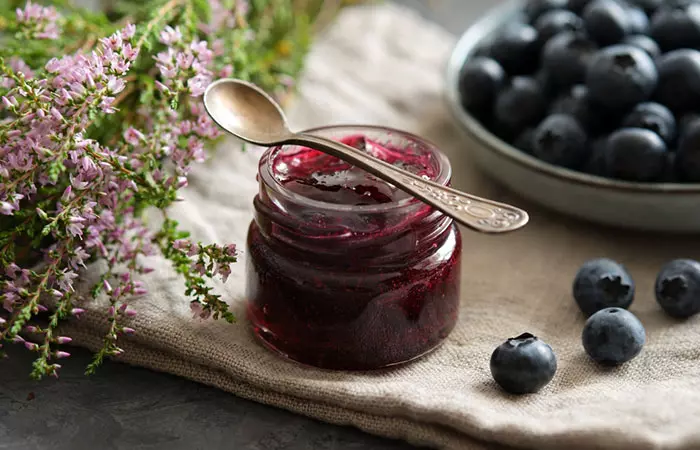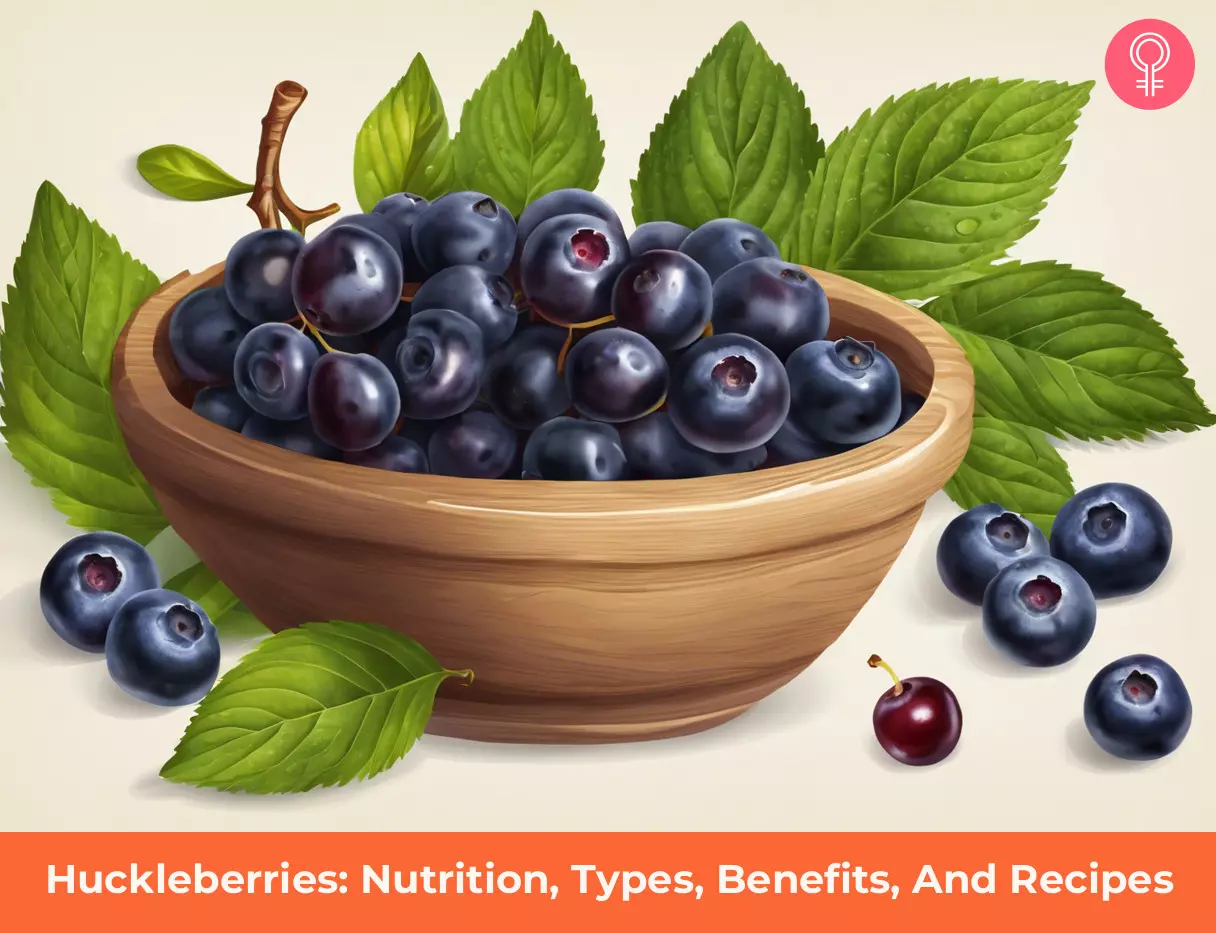This article explores the types of huckleberry, its nutrition, health benefits, how it differs from blueberry, and the simple huckleberry recipes you can try at home. Keep reading.
What Is Huckleberry?
Huckleberry is a member of the Ericaceae family and is closely related to the Gaylussacia and Vaccinium genera. These berries are 5 mm to 10 mm in diameter and contain 10 large seeds. They have a tart taste and flavor similar to that of blueberries, and their colors range from bright red to dark purple to blue. They are used in various foods and beverages. What Are Its Benefits? It helps boost immunity and may help reduce cardiovascular disease and cancer risk, lower cholesterol levels, and protect against diabetes, osteoporosis, and neurodegenerative diseases. Who Can Use It? Anyone except individuals who are allergic to berries. How Often? You can consume these berries fresh or have jams, puddings, beverages, and other foods containing these berries daily. Caution Excess consumption of these berries can cause adverse effects like skin sensitivity and indigestion. Limit consumption and seek medical advice if you experience any side effects.
Andrea, a blogger, found huckleberries to be a great addition to desserts and shared her experience of having them the first time: “They look like tiny blueberries but have a much more intense flavor — delicious! Miss E loved them, especially in the huckleberry pancakes she had for breakfast (i).”
Types Of Huckleberries
Red Huckleberry (Vaccinium parvifolium)
It is native to Western North America, and the shrub grows from 6 feet to 12 feet. The berry has a tart and sour taste and is used to make pies, jellies, and jams.
Oval Leaf Huckleberry (Vaccinium ovalifolium)
The shrub grows from 1.3 ft to 12 ft and the leaves are oval. The fruit is a blue‐black berry with a whitish bloom and is used in jellies, jams, liquors, and dyes (Russia).
Cascade Huckleberry (Vaccinium deliciosum)
This berry has an intensely sweet flavor and can be eaten fresh, dried, or cooked. The shrub cannot grow more than 1.5 ft.
Evergreen Huckleberry (Vaccinium ovatum)
Also known as winter huckleberry or California huckleberry, this fruit is found in coastal forests at low elevations from central California to British Columbia. These berries are sweeter than blueberries and can be eaten raw, dried, and used in jellies and jams.
Big Huckleberry (Vaccinium membranaceum)
This fruit is also popular as thin leaf, mountain, or tall huckleberry. It is found in coniferous forests at mid‐to‐high elevations from California to Alaska and east to the Rockies. The shrub can grow up to 1.5 m, and the berry can be eaten raw, dried, frozen, canned, or made into jam.
Nutritional Profile Of Huckleberries
According to the U.S. Department of Agriculture, 100g of huckleberries (raw) contain (1): Huckleberries are also rich in plant polyphenols and anthocyanins that benefit your health in many ways. We will explore some of the important benefits of huckleberries in the following section.
Health Benefits Of Huckleberry
The high polyphenolic and phytonutrient content in huckleberries help reduce the risk of heart problems. A study conducted by the Medical University of Lodz (Poland) found that plant polyphenols may help improve endothelial functioni Endothelium (central cell inside the lining of blood vessels and the heart) regulates platelet collection and maintains blood fluidity. and prevent clumping of platelets and blood clots. These antithrombotic (anti-blood clotting) and anti-inflammatory properties of polyphenols may reduce cardiovascular disease (CVD) risk (2). A review published in Advances in Nutrition also suggests that increased intake of anthocyanins may improve endothelial functioni Endothelium (central cell inside the lining of blood vessels and the heart) regulates platelet collection and maintains blood fluidity. and pro-inflammatory biomarkers. This may help lower CVD risk. However, more studies are warranted to understand this benefit of anthocyanins (3). Besides, many species of Vaccinium were found effective in decreasing high blood pressure, which is one of the main causes of heart disease (4). Moreover, anthocyanins in berries act as an antioxidant and may suppress and reduce the risk of cancer (5). These compounds may also improve neuronal and cognitive brain functions besides protecting genomic DNA integrity (6). Moreover, epidemiological studies strongly suggest that long-term intake of diets rich in polyphenols may also protect against cancers, diabetes, osteoporosisi A medical condition in which the loss of density and minerals in bones causes them to become frail and prone to fractures. (weak and brittle bones), and neurodegenerative diseasesi A group of diseases that adversely affects the nervous system connections, causing diseases like Parkinson’s and Alzheimer’s. (7). The high vitamin C content of huckleberries also helps improve immune health. This potent antioxidant helps act against oxidative stress and pathogens and prevents excess call damage (8). Berries from the Vaccinium family have the potential to prevent and treat urinary tract infections (9). Besides, anecdotal evidence suggests that huckleberries may help relieve back pain. Ripe huckleberries are sweet with a little tartness. But how do you eat them? Let us find out.
How To Eat Huckleberries?
Though huckleberries can be eaten fresh, they are often made into tasty beverages, jams, puddings, candies, syrups, and other foods.
Use huckleberries to make delicious muffins, pies, or cobblers. You can even use them for savory dishes like lemony quinoa with chickpeas and huckleberries. Some find huckleberries unpleasant when eaten raw because of their meaty texture. Hence, it is best to cook them instead. You can even preserve their tart/sweet flavor with jams and jellies.
Are huckleberries and blueberries the same? If no, how do they differ? Keep scrolling to know the answer.
Huckleberries Vs. Blueberries
The two berries are closely related and belong to the same family. However, huckleberries grow in small clusters and blueberries in large ones. Blueberries are white inside while huckleberries are either deep purple or red. Moreover, blueberries are soft inside with softer seeds while huckleberries have larger seeds that give the fruit a slight crunch. Here, you can also explore the numerous benefits of blackberries, as it will inform you about its nutritional profile and recipes, helping you to form a real-time comparison with huckleberries. Low calorie huckleberries are a perfect addition to your diet. Here, we bring to you three delicious huckleberries to try at home.
Huckleberries Recipes To Try
1. Huckleberry Jam
What You Need
Wild huckleberries – 1 cup Fresh lemon juice – 2 teaspoons Cane sugar – 1 cup Classic powdered pectin – 2 teaspoons
Process
2. Huckleberry Buckle
What You Need
Huckleberries – 2½ cups Butter – ¼ cup and 1 tablespoon All-purpose flour – 1 cup White sugar – ½ cup and ¾ cup Baking powder – 1 teaspoon Salt – ¼ teaspoon Milk – ½ cup Boiling water – ½ cup
Process
3. Huckleberry Cheese Pie
What You NeedFor Butter Crunch Crust
Brown sugar – ¼ cup All-purpose flour – 1 cup Cold butter – ½ cup Finely chopped nuts – ½ cup
For Cheese Filling
Whipped cream – 1 cup Cream cheese – 1 package (8 ounces) Vanilla extract – 1 teaspoon Confectioners’ sugar – ¾ cup
For Fruit Topping
Fresh huckleberries – 2 cups Sugar – ½ cup Corn starch – 4½ teaspoons Water – ½ cup Butter – 1½ teaspoons Dash salt
Process Note: Huckleberries have no recorded side effects. Practice caution if you are allergic to blueberries. You can savor huckleberries throughout the year by preserving them. But it’s important you do that right. Learn more in the section below.
How To Store Huckleberries?
Huckleberries can be kept fresh for up to 7-14 days or stored in a freezer for up to a year. Remember to wash them gently before storage. For shorter-term storage (up to 14 days):
Keep them in the refrigerator in an airtight container. You can also turn them into delicious treats such as jams and pies that may last up to a month.
For long-term storage (up to a year):
Rinse them and remove any leaves or sticks. Place them in a layer on a baking sheet and put them in the freezer until they become hard. Store the frozen huckleberries in an airtight container or a ziploc bag.
These steps will keep them from getting clumped together and preserve their freshness in the freezer for up to a year. Are huckleberries a superfood? Yes, huckleberries can be considered a superfood. They are loaded with many beneficial nutrients that help reduce the risk of oral diseases, ocular diseasesi Diseases that affect overall eye health and cause impaired vision. Examples include astigmatism, cataracts, and color blindness. , and arthritisi A condition in which one or more joints becomes inflamed, causing pain and stiffness due to bone deterioration. . When should you eat huckleberries? Huckleberries should be eaten when they are entirely ripe. They should be dark black and must have a slightly soft texture. Do huckleberries have vitamin K? Yes, huckleberries have a decent amount of vitamin K. Are huckleberries poisonous? Huckleberries are not poisonous. However, garden huckleberries can be toxic if consumed raw. Does huckleberry tea have caffeine? No, huckleberry tea does not contain caffeine.
Illustration: Huckleberries: Nutrition Types Benefits And Recipes
The remarkable huckleberry, with its unique blend of sweet and tart flavors, often gets mistaken for blueberries. However, it possesses distinctive qualities in terms of size, texture, and taste that set it apart. Explore more in this engaging video!












